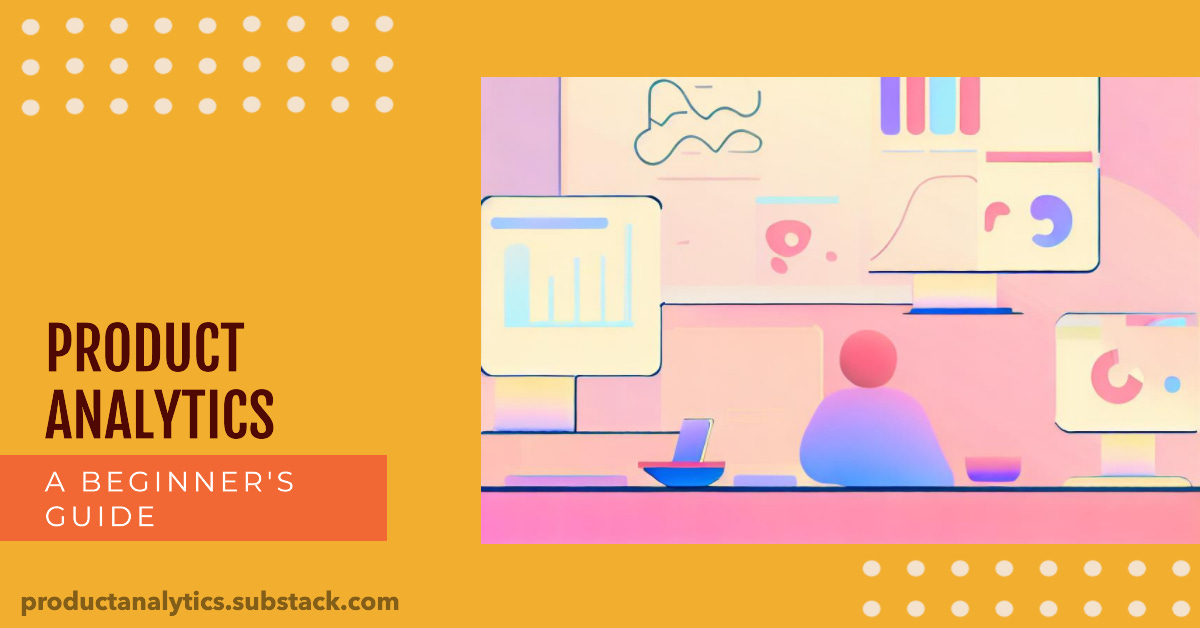A Beginner's Guide to Product Analytics
What is "Product Analytics"? How It's Different from other fields? and How can you be a great Product Analyst?
If you're interested in data-driven decision making and the world of product management, you've likely come across the term "product analytics." But what exactly is it, and how can you get started? These were the same questions that I had 4 years ago when I joined the fledgling Product Analytics team at Razorpay. Up until then, I had never heard the term “Product Analytics” though I had worked in Data Consulting for 2+ years.
Here, I'll attempt to provide answers to questions that I had then, as well as queries from numerous other people who have reached out to me regarding Product Analytics.
What is Product Analytics?
At its core, product analytics is the process of using data to improve the performance of a product. This can involve everything from understanding user behaviour and preferences to optimizing pricing and marketing strategies.
But while other forms of analytics may focus on overall business performance or specific marketing metrics, product analytics is unique in its laser focus on the product itself. By analysing data related to user engagement, feature usage, and other product-specific metrics, product analysts can gain deep insights into how a product is performing and what can be improved.
How is Product Analytics Different from Other Analytics Disciplines?
While product analytics shares many similarities with other analytics disciplines, there are some key differences that set it apart. We can examine this by studying the niche occupied by product analytics along two different axes, within the wider data and analytics discipline:
Source of data analysed
Customization required for metrics
Product Analytics requires its practitioners to a) work on data that is primarily product-generated (as opposed to data from third-party tools) and b) customize the metrics being tracked, to suit the unique needs of the individual product
I’ve tried to map some major analytics disciplines, along these two axes (x axis representing the source of data/ y-axis representing the customization required)
Let’s look at where Product Analytics stands with respect to each of these axes separately.
Based on the source of data analysed
Product analytics is typically based on data collected directly from the product itself.
Other analytics disciplines may rely on data from a variety of sources, including third-party tools like CRMs (eg. Salesforce), Ad-tracking (eg. Google Ads), Accounting Software (eg. Quickbooks), and social media platforms.
This key differentiation results in an important skill that product analysts need to excel at their jobs: owning the data production architecture.
Great product analysts work with PMs and Engineers to
define how events need to be sent from the UX
what properties the events should have and their data structures (integers, arrays, JSONS)
define and build the data schema for how information needs to be stored for reporting and analytical workloads
Based on the customization required for metrics
Each product is unique, with it’s own set of business goals, internal terminology, technical architecture and processes. What this means in practise is that aligning on what metrics to measure for a product and defining their calculation is not a straightforward task.
To illustrate the difference, let’s compare this with a field like Financial Analytics which has very robustly defined metrics like ARR, EBITDA, NRR and so on. The metrics, what they mean, and how they ought to be calculated are very well defined. Moreover, all stakeholders are aligned on why these metrics matter. The last point especially is something newcomers to the field (including myself) miss.
Even if you are able to define a metric and measure it, it’s just half the work done. A product analyst has to evangelize these metrics among the people who can take action on them. This requires a great deal of communication skills, and empathy for your colleagues.
The nature of “analysis” in Product Analytics
1. Focus on user behaviour
Picture Credit: Christina Morillo
Perhaps the most significant difference between product analytics and other forms of analytics is the focus on user behaviour. Product analysts are primarily concerned with understanding how users interact with products and services, and using that understanding to drive product development and optimization.
2. Emphasis on experimentation
Picture Credits: Artem Podrez
Product analytics also places a strong emphasis on experimentation and iteration. Rather than relying solely on historical data to make decisions, product analysts are often involved in designing and executing experiments to test hypotheses and validate assumptions.
For example, developing A/B tests to identify which promotional campaign results in the highest improvement in conversion rates.
This requires a deep understanding of statistical methods and experimental design, as well as an ability to work collaboratively with other stakeholders to design effective experiments.
3. Involvement in product development
Product analysts are closely involved in product development working alongside product managers, designers, and engineers. This requires a working knowledge of the product development lifecycle, tools and processes in a firm.
A Brief History of Product Analytics
While the field has evolved rapidly over the past decade, it’s helpful to understand its beginnings. Product analytics can trace its roots back to the early days of web development, when companies like Amazon and Google began collecting large amounts of data on user behaviour. As these companies grew and became more sophisticated, they began to use this data to drive product decisions and optimize their offerings.
One of the earliest examples of product analytics in action was Amazon's "People who bought this also bought" feature, which was introduced in the late 1990s. By analysing purchase data, Amazon was able to recommend related products to customers and increase sales.
In the years that followed, other companies began to adopt similar approaches, using data to inform product decisions and drive growth. Product Analytics truly took off in the era of social media when early pioneers - Facebook and LinkedIn combed their data to identify user behaviours that resulted in better retention.
As the field of product analytics evolved, new tools and technologies emerged to support it. In the mid-2000s, a new generation of web analytics tools like Google Analytics and Omniture (now Adobe Analytics) were introduced.
More recently, the rise of mobile apps and other digital products has led to the development of specialized product analytics tools and platforms. Companies like Mixpanel, Amplitude, and Heap offer powerful analytics tools specifically designed for mobile and web products.
What Skills are Required to Succeed as a Product Analyst?
Based on my own experience, and those of people I work with - I believe these are some key skills that are essential for success as a product analyst:
1. Analytical skills
This means the ability to identify patterns, draw insights, and make data-driven decisions. Analysts must be comfortable working with large data sets and able to use tools like SQL, Python, and Excel to analyse and manipulate data.
If there is just one skill that you can acquire over the next 6 months, and you want to enter product analytics- learn SQL. I can’t emphasize enough how crucial of a skills this is, in product analyst workflows across organisations.
2. Product acumen
Product analysts must also have a strong understanding of the product context in which they operate. They must be able to translate data insights into actionable recommendations that drive product growth, and be able to communicate these insights to stakeholders across the organization.
The best place to learn this is on the job, in my opinion. If you’re working in a Fintech product for example - learn everything about the product, the market it operates in, the business challenges, and the competitive landscape. This is one of those things that set apart a “good” product analyst from a “great” one.
3. Proficiency with Analytical Tooling
As a product analyst, you will be working with a wide range of technical tools and platforms, including web analytics tools like Google Analytics, data visualization tools like Tableau, and data storage tools like AWS S3.
While there are a plethora of tools available in the market, and each organization has its own analytical stack - the skills are fairly transferable. Familiarity with common data storage and querying technologies like Hadoop is an added advantage.
4. Collaboration skills
Finally, product analysts must be able to work effectively in cross-functional teams, collaborating with product managers, designers, engineers, and other stakeholders to drive product success. This requires strong communication skills, as well as an ability to navigate complex and sometimes conflicting priorities.
Pathways to Product Analytics
Picture Credit: James Wheeler
I will probably write a separate article sometime down the line since this is something that’s close to my heart. However, I will summarize my high-level ideas on this subject.
In my opinion, online product analytics certifications and training programs are not a great way to set yourself for success in this field. Like mentioned previously, one of the major differentiators that sets apart Product Analytics is the level of customization required for metrics i.e. metrics modelling. In most organizations, this is a very messy process which requires you to get your hands dirty with the code and data, talk to multiple stakeholders and win support for your proposed metrics. This is very difficult to replicate in an academic environment, and requires actual work experience.
So, the next question becomes - how does one get a job as a product analyst? Most companies don’t hire product analysts straight from undergrad. We sadly don’t have many programs similar to APM (Associate Product Management) or Software internships to groom and develop budding product analysts. And, there aren’t yet specializations / certifications that are well-recognized in the industry.
My thoughts here are to first start working with data (any type of data really), and then leverage the skills learnt (SQL/ Visualization/ Modelling/ Stakeholder Management) to apply for jobs in the Product Analytics space. With regards to how to enter data roles, my suggestion would be to focus on just 3 skills:
SQL
Excel/ Google Sheets
One data visualization tool of your choice
There are great free resources out there to get one started such as
Tableau Public (Great place to learn and explore creating visualizations in Tableau, one of the most popular BI solutions in the market)
I hope this helped you get a sense of what Product Analytics is about, and how you can get into the field. If there are any questions, feedback that you have - please shoot me a message here :)








This was an excellent read with many details and neaunces. My only suggestion is probaly the length of the article felt like too long. Probably you could have divided into multiple posts.
Anyways, thanks once-again explaining it in a very simple and no-jargon language
Informative article. Lengthy, so I couldn't read all of it. It is interesting to see how the field of UX overlaps with Product analytics. This should be avoided among disciplines. If there is an overlap that goes beyond a certain degree, a new field shouldn't be introduced, many of these features are being done in UX, like understanding the user, user testing, and iteration. Just combine the new features to the existing field. That's it. Less complications. I would go as far as saying this field of Product Analytics is non-existent, and not needed. There's Lean Analytics, which also does the same things.